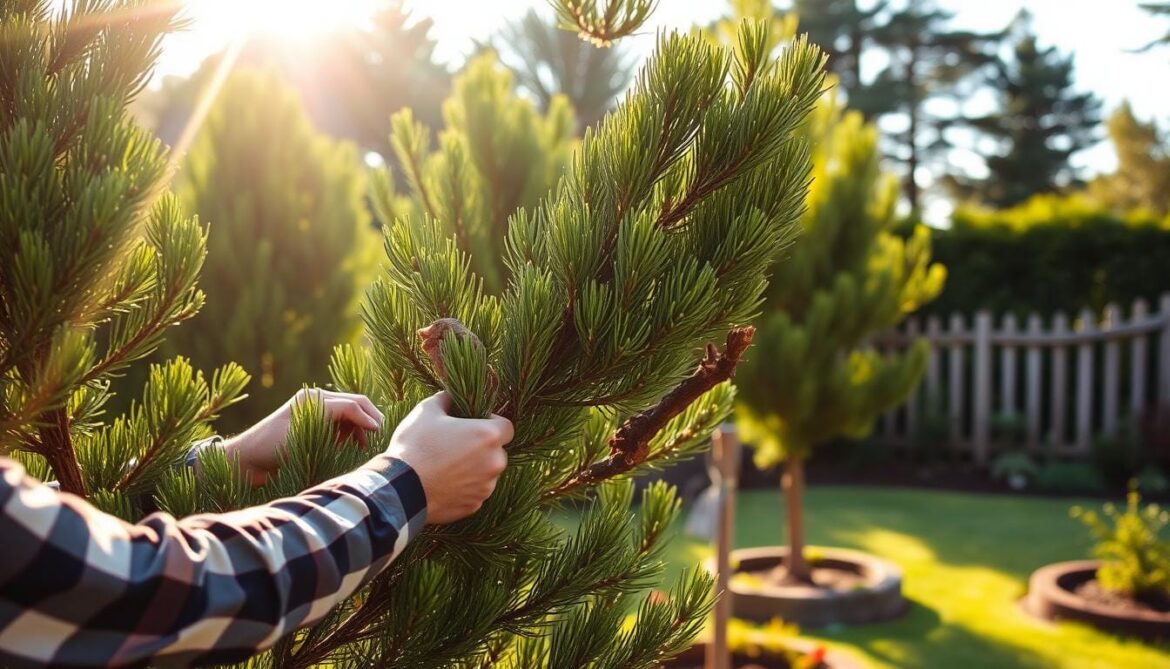Pine trees are a majestic addition to any residential landscape, but they require regular maintenance to maintain their health and aesthetic appeal. Understanding the proper techniques for cutting back pine trees is essential for gardeners who want to ensure their trees thrive for years to come.
Proper pruning not only enhances the visual appeal of pine trees but also contributes significantly to their overall health and longevity. By learning the best practices for trimming and pruning, gardeners can achieve professional-looking results and keep their pine tree safe and healthy. For more information on common issues that may require pruning, such as disease control, visit this resource on common pine tree diseases.
Key Takeaways
- Regular maintenance is crucial for the health and aesthetic appeal of pine trees.
- Proper pruning techniques enhance the visual appeal and contribute to the overall health of pine trees.
- Understanding the best practices for trimming pine trees is essential for gardeners.
- Pruning can help control disease and maintain the natural shape of pine trees.
- Professional-looking results can be achieved by following expert guidelines for cutting back pine trees.
Understanding Pine Trees and Their Growth Patterns
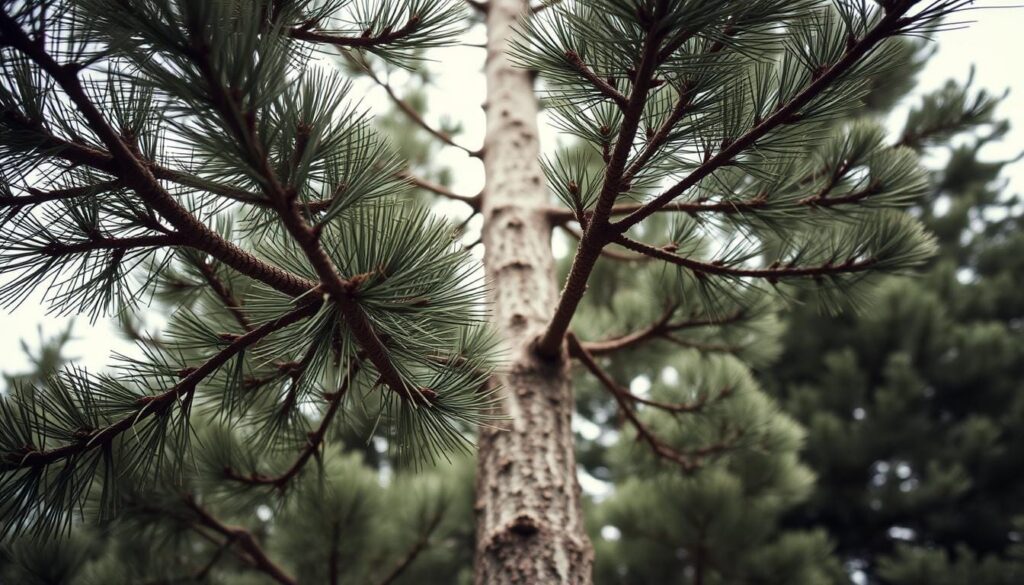
Understanding the growth patterns of pine trees is essential for effective maintenance and trimming. Pine trees encompass a wide range of species, each with its unique characteristics and visual appeal.
Common Pine Tree Species in Residential Landscapes
Pine trees come in various species that are popular in residential landscapes. The Eastern White Pine and Scots Pine are two examples that are commonly found. Each species has its own distinct qualities, such as varying growth rates and needle structures, which affect how they should be maintained and trimmed.
Unique Growth Characteristics of Pine Trees
Pine trees exhibit a distinctive growth habit with a central leader and lateral branches that develop in tiers. This creates their characteristic shape and requires special consideration when trimming to avoid damaging the tree’s appearance and health.
Why Pine Trees Need Regular Trimming
Regular maintenance of pine trees is necessary to remove dead or damaged branches, control size, and improve air circulation. This helps maintain the tree’s natural form and prevents potential hazards from falling branches.
The Best Time for Cutting Back Pine Trees
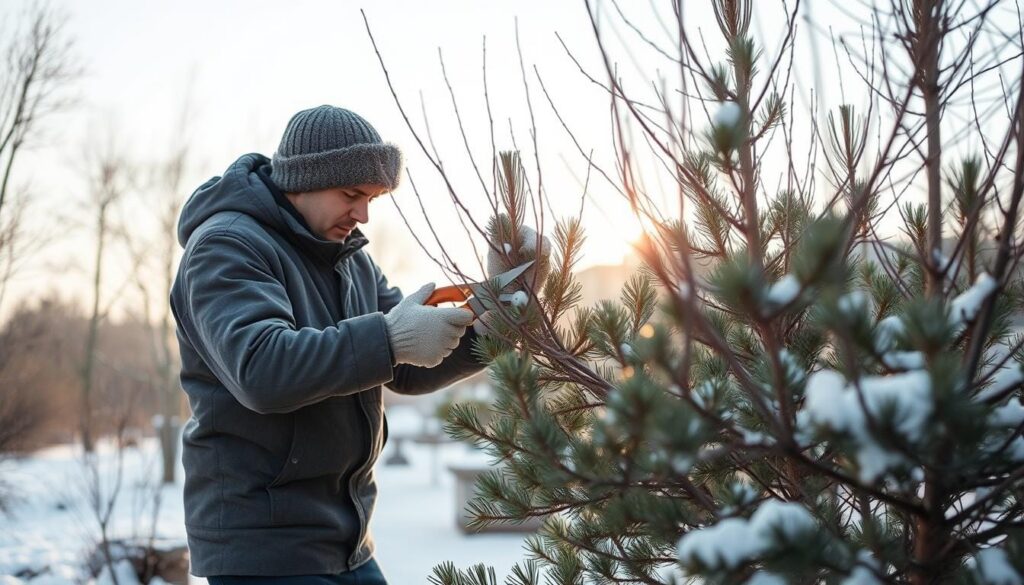
Understanding when to trim pine trees is essential for gardeners who want to keep their trees healthy and thriving. The timing of pruning can significantly impact the health and appearance of pine trees.
Dormant Season: Late Winter to Early Spring Advantage
The best time to start pruning pine trees is during their dormant season, typically in late winter to early spring. This period is advantageous because the tree is not actively growing and is less vulnerable to stress. Trimming during this time promotes healthy regrowth and allows the tree to allocate its resources effectively.
Avoiding Active Growth Periods
Pine trees are particularly sensitive to timing when it comes to pruning. Cutting during active growth periods can lead to excessive sap flow and increased vulnerability to pests and diseases. It’s best to avoid trimming during late summer or fall, as cuts made during this time won’t have sufficient time to heal before winter, potentially leading to frost damage and disease entry points.
Species-Specific Timing Considerations
Different pine species may have slightly different optimal trimming times. For example, for candle pruning (pinching back new growth), the best time is in late spring when the new growth (candles) has elongated but before the needles fully expand. Understanding the growth cycle of your pine trees will help you determine the most appropriate timing for different types of trimming activities.
Essential Safety Precautions Before Trimming
Pine tree trimming requires careful planning and attention to safety to avoid accidents. The process involves working at heights, handling sharp tools, and dealing with potential hazards.
Required Safety Equipment and Tools
Essential safety equipment for pine tree trimming includes protective eyewear, sturdy gloves, a hard hat, non-slip footwear, and hearing protection if using power tools. Having the right equipment is crucial for minimizing the risk of injury.
Assessing Potential Hazards
Before beginning any trimming work, conduct a thorough assessment of the area to identify potential hazards such as power lines, unstable ground, or structural obstacles. This step is vital for ensuring a safe working environment.
Proper Ladder and Climbing Techniques
When using ladders to reach higher branches, ensure they are placed on stable, level ground and follow the “three-point contact” rule (two feet and one hand or two hands and one foot in contact with the ladder at all times). This technique helps prevent accidents caused by ladder instability.
Additional safety tips include avoiding work in adverse weather conditions, being aware of the weight and fall path of branches, and establishing a clear drop zone. For complex trimming jobs, consider hiring professional tree trimming services that have the proper equipment and expertise to handle the task safely.
Proper Techniques for Cutting Back Pine Trees
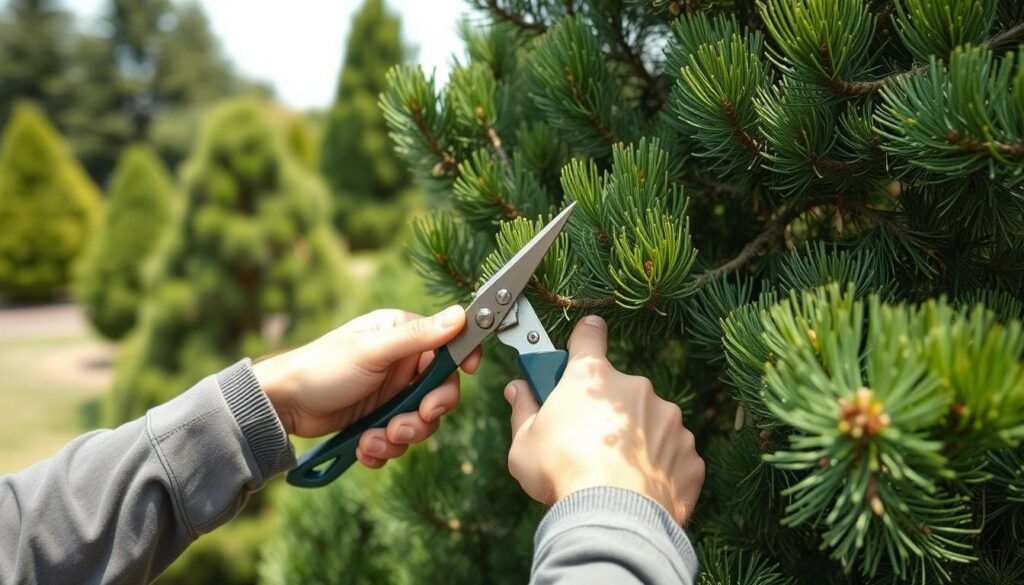
To keep pine trees thriving, it’s essential to master the proper techniques for cutting them back. Trimming pine trees is a delicate process that requires understanding the tree’s growth patterns and needs.
Assessing Your Pine Tree’s Trimming Needs
Before you start trimming, it’s crucial to assess your pine tree’s specific needs. Identify dead, damaged, or diseased branches that need removal, as well as areas where growth control is necessary. This assessment will help you determine the best approach for trimming your pine tree.
- Look for branches that are rubbing against each other or are damaged.
- Check for signs of disease or pest infestation.
- Consider the overall shape and density you want to achieve.
Candle Pinching for Controlled Growth
Candle pinching is a technique used to control the growth of pine trees by breaking off the new growth tips, or “candles,” in spring. This method encourages denser foliage and a more compact growth pattern. To pinch candles, simply break them off by hand at about the middle. Avoid cutting them with shears, as this can damage the needles.
Branch Removal Best Practices
When removing branches from pine trees, it’s vital to cut them back to the branch collar, the thickened area where the branch meets the trunk. For larger branches, use the three-cut method to prevent bark tearing: make an undercut about a foot from the trunk, followed by a top cut slightly further out, and finally remove the remaining stub with a clean cut at the branch collar.
Avoiding Common Pruning Mistakes
To maintain the health and appearance of your pine tree, avoid common pruning mistakes such as topping the tree, removing too many branches at once, or cutting into the woody parts of branches. These practices can stress the tree and lead to long-term damage. Instead, focus on minimal intervention and maintain the tree’s natural shape.
- Avoid cutting into the woody part of branches.
- Maintain the tree’s natural pyramidal shape.
- Use sharp, clean tools to ensure clean cuts.
5 Expert Tips for Effective Pine Tree Maintenance
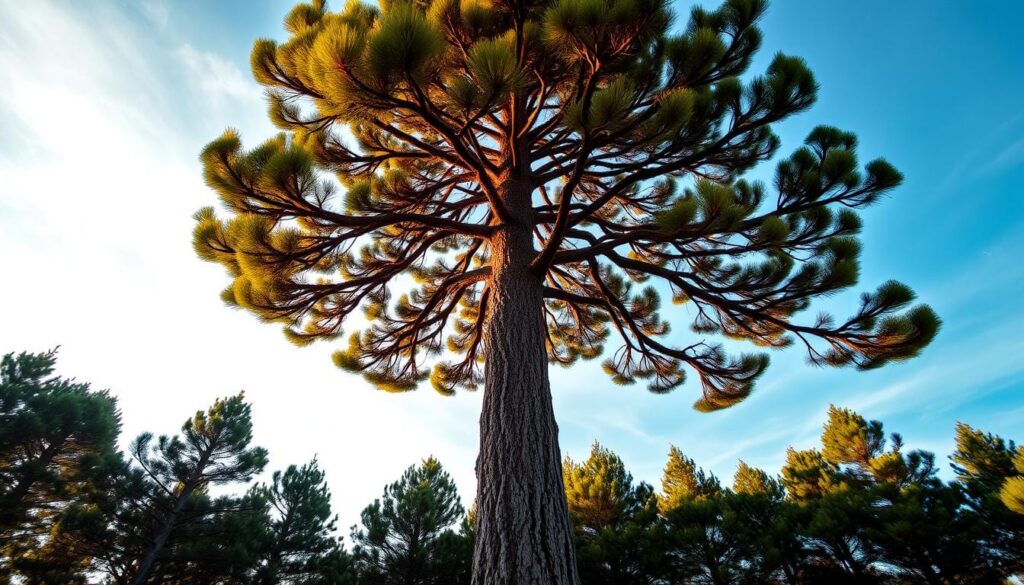
To keep your pine trees thriving, it’s essential to follow expert tips on maintenance and trimming. Proper care can enhance the beauty and longevity of your trees, ensuring they remain healthy and continue to be a beautiful part of your landscape.
Tip1: Removing Dead or Damaged Branches
Prioritizing the removal of dead or damaged branches is crucial as they not only detract from the tree’s appearance but also serve as entry points for diseases and pests that can threaten the entire tree’s health. Removing these branches helps prevent the spread of disease and encourages healthy growth. It’s a simple yet effective way to maintain your pine tree’s overall well-being.
Tip2: Limbing Up for Increased Sunlight
“Limbing up” or removing lower branches is an effective technique to increase sunlight penetration to understory plants and improve air circulation around the pine tree. This helps prevent fungal diseases that thrive in moist, shaded conditions. By limbing up, you can also create an attractive shape for your pine tree, enhancing its aesthetic appeal.
Tip3: Maintaining the Tree’s Natural Shape
Always work to maintain the pine tree’s natural conical or pyramidal shape when trimming. This preserves its structural integrity and aesthetic appeal while supporting healthy growth patterns. A well-maintained shape also ensures that the tree continues to grow in a balanced and visually pleasing manner.
Tip4: Addressing Rubbing or Crossing Branches
Identify and remove any rubbing or crossing branches, as these create wounds that can become entry points for insects and diseases. In cases where branches are crossing, preserve the one with the healthier growth pattern. This proactive approach helps protect the health of your pine tree and prevents potential issues.
Tip5: Post-Trimming Care for Optimal Recovery
Proper post-trimming care is essential for optimal recovery. This includes adequate watering, especially during dry periods, and applying a layer of mulch around the base to retain moisture and suppress weed growth. Regular monitoring for signs of stress or disease is also crucial, allowing you to take appropriate action if needed.
By following these expert tips, you can ensure your pine trees receive the care they need to thrive. Regular maintenance not only enhances their appearance but also contributes to their overall health and longevity.
When to Hire Professional Tree Trimming Services

Professional tree trimming services offer numerous benefits for pine tree maintenance. Experts bring a deep understanding of tree health and maintenance, ensuring optimal trimming practices that promote vitality and longevity.
Consider hiring professionals for pine trees that are exceptionally tall or near power lines. They possess the expertise to assess tree health accurately, identifying signs of disease or structural issues. Professionals are equipped to handle the inherent risk associated with trimming, ensuring safety for both property and personnel.
Key scenarios that necessitate professional services include:
- Pine trees with complex structural issues or storm damage.
- Trees requiring extensive trimming that may affect their overall health or appearance.
- Pine tree trimming needs that demand specialized knowledge about pine species and their growth patterns.
By hiring expert services, homeowners can ensure their trees receive the best care, minimizing risk and promoting long-term health.
Conclusion
Effective pine tree maintenance is a blend of knowledge, technique, and timing, all of which contribute to the long-term health of your trees. By understanding the unique growth patterns of pine trees and adhering to the recommended trimming schedules, gardeners can ensure optimal results with minimal stress to the tree.
Trimming pine trees is an essential aspect of landscape maintenance that significantly enhances both the aesthetic appeal of your property and the health of these majestic evergreens. Regular care and maintenance practices help prevent potential hazards from falling branches while enhancing the trees’ natural beauty and structural integrity.
Whether you choose to trim your pine trees yourself or hire professional services, the knowledge gained from this guide will help you make informed decisions that contribute to the health, safety, and beauty of your pine trees for years to come. By implementing the expert tips provided, gardeners can develop a comprehensive approach to pine tree care that balances aesthetic goals with the biological needs of these valuable landscape elements.
